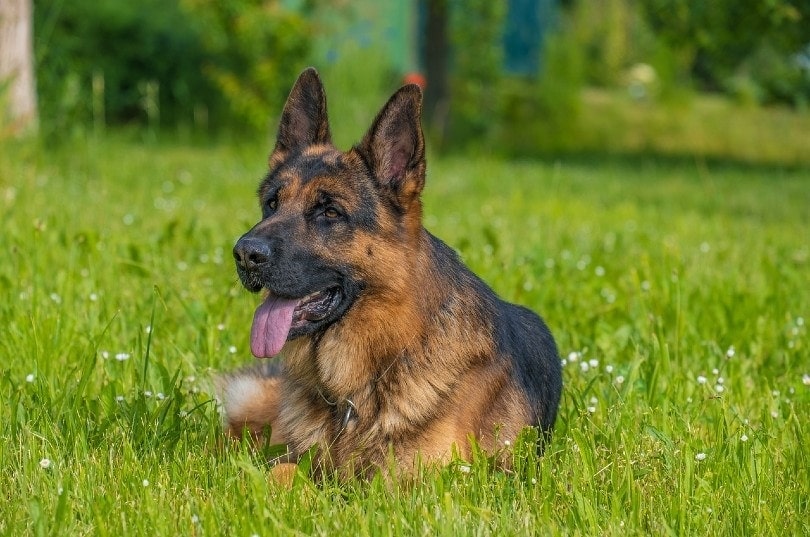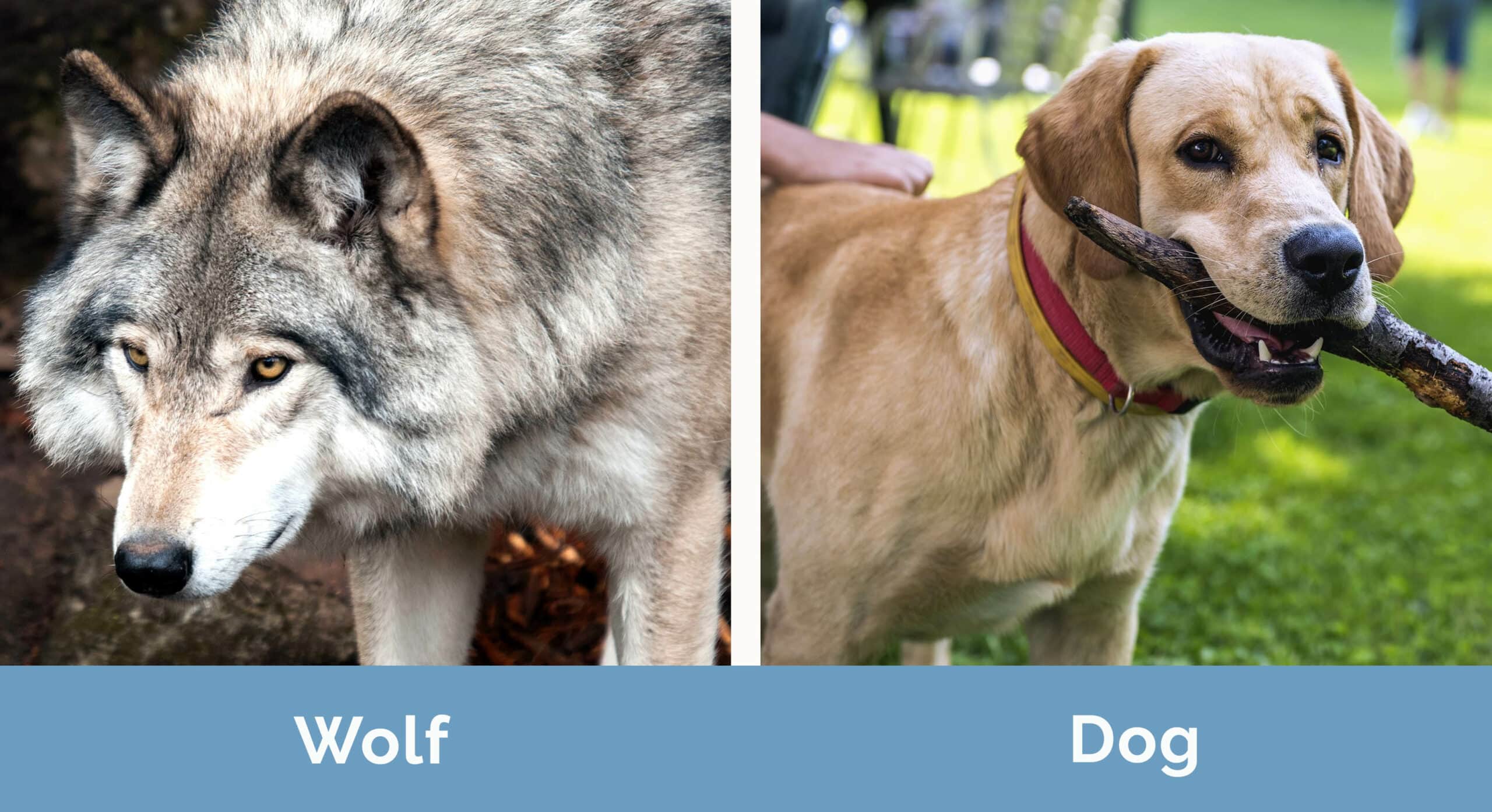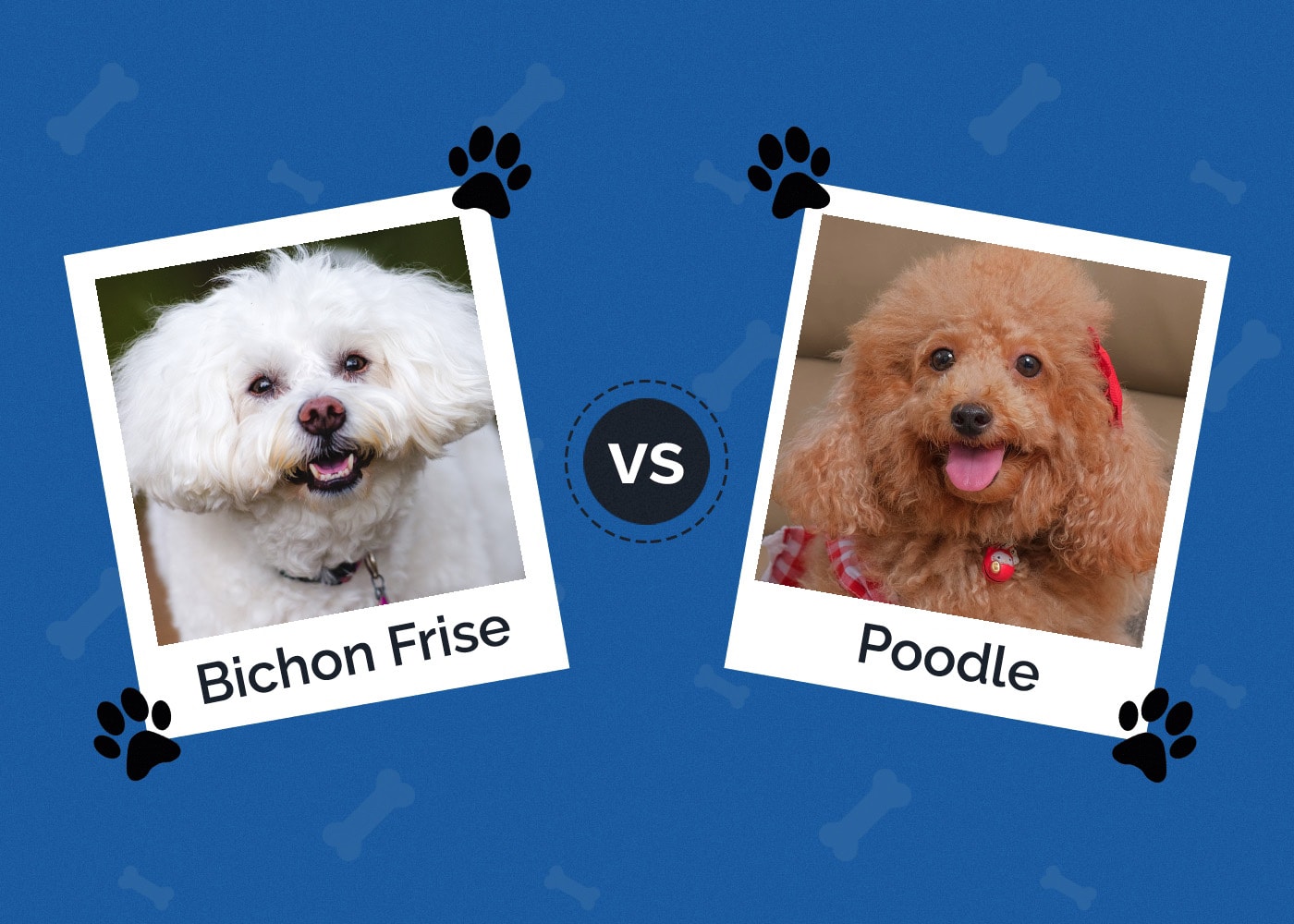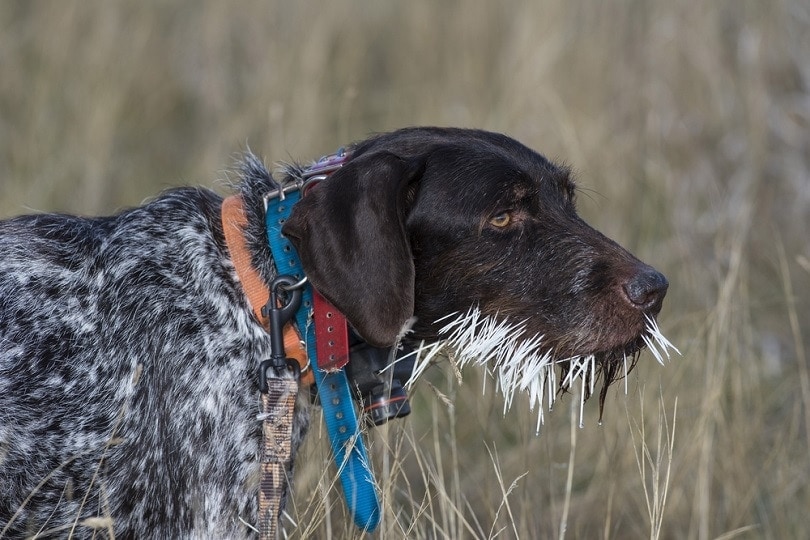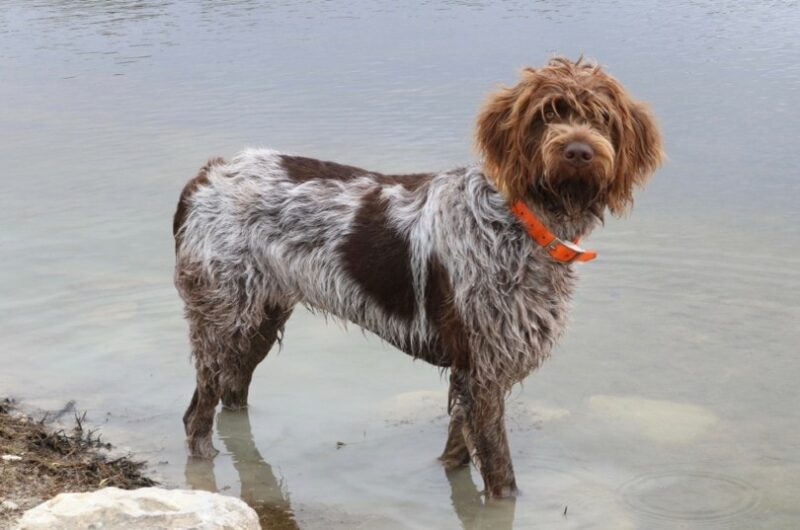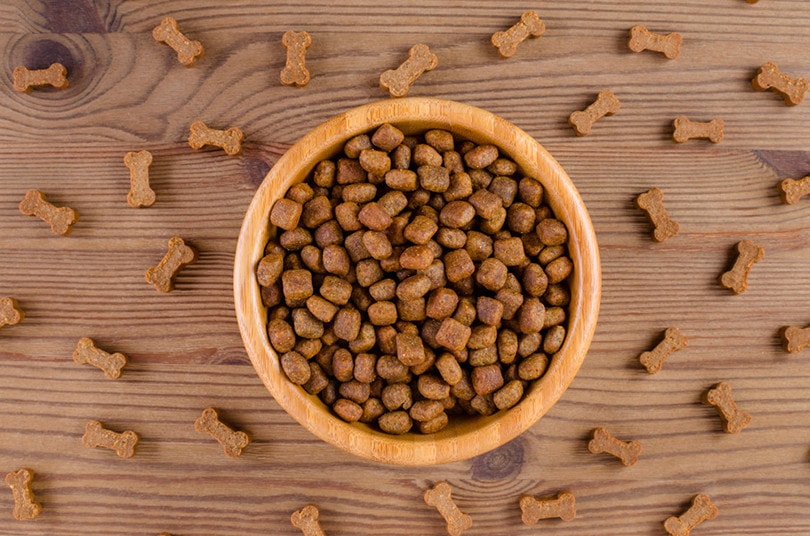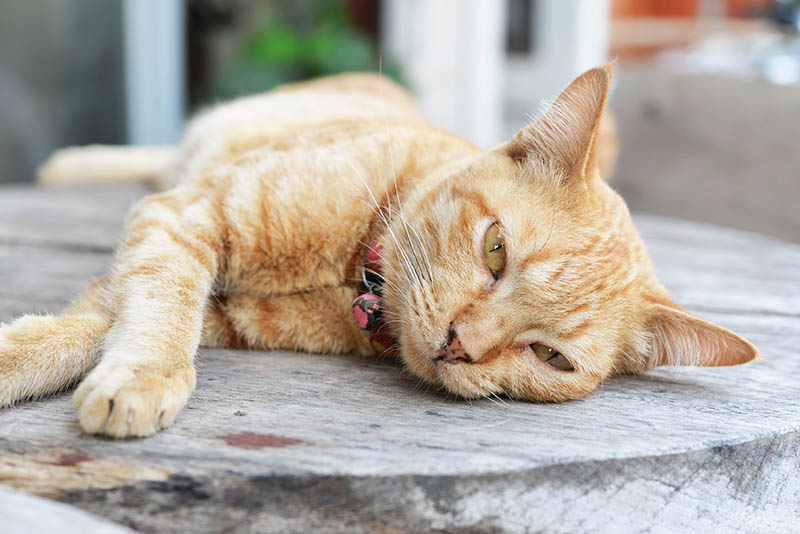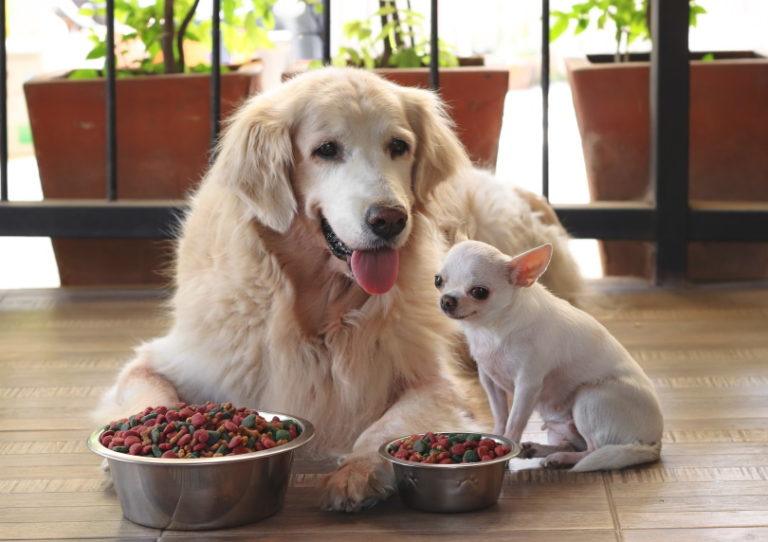8 Majestic Dogs That Are Bigger Than Wolves (With Pictures)
By Ashley Bates
Updated on
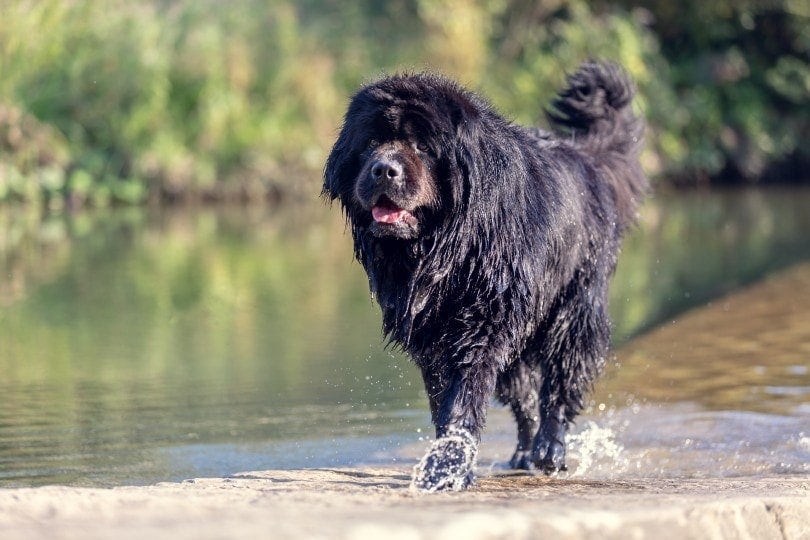
It’s pretty common knowledge that all of the domestic canines that we know and love today are derived from wolves. Wolves were bred down, combining different genetic characteristics to achieve the breeds we see now.
However, while dogs certainly have gotten smaller over time, several dog breeds are just as big as wolves, if not bigger. Here are eight dog breeds that trump their wolf cousins.
The 8 Dogs That Are Bigger Than Wolves
1. Irish Wolfhound
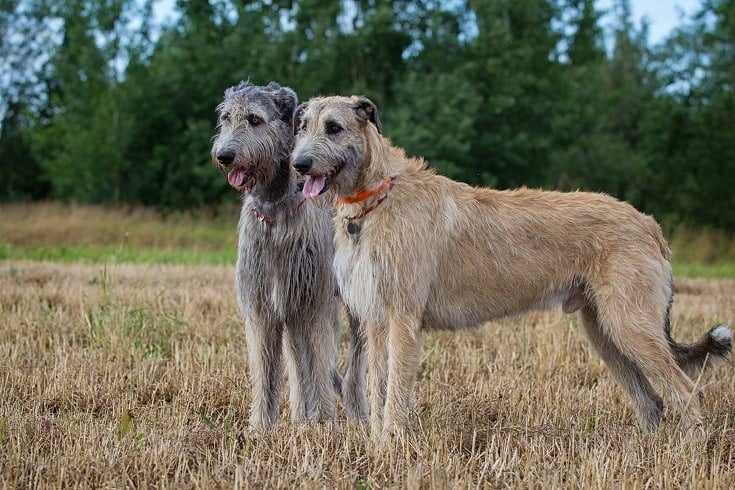
| Category: | Hound Group |
| Height: | 32 inches |
| Weight: | 130–180 pounds |
| Colors: | Black, white, brindle, fawn, gray, red |
For good reason, the Irish Wolfhound is first on the list. They were quite literally bred to hunt and track wolves that endangered locals. To take on a pack of wolves, the dog must be physically capable of overpowering these wild beasts.
Generally, the Irish Wolfhound can outweigh the gray wolf by 30 to 60 pounds. In Europe, wolves are a bit smaller than their North American cousins, so Irish Wolfhounds certainly towered over them at one point in time.
Origin
The Irish Wolfhound is an absolutely impressive specimen dating back to the 19th century. G.A. Graham aimed to revamp potentially extinct Wolfhounds from Ireland and succeeded in doing so. This large sighthound impressed with agility, speed, strength, and companion capabilities.
In addition to warding off wolves and protecting farms and families, the Irish Wolfhound was also trained to hunt larger game like boar and deer.
Personality
Irish Wolfhounds are graceful, poised pups with an ancient sense about them. Often, owners and onlookers would explain these dogs as gentle giants who are keen, sensitive, and relaxed. They make excellent candidates for advanced or simple training if you want an easy learner.
These hefty boys and girls are terrific choices for children, as they are patient and adventurous. They are very good judges of character and acclimate well to various lifestyles. Despite impressive speeds, these dogs take a more lackadaisical approach to things.
Health
Irish Wolfhounds have evolved to be healthy animals but have some breed-specific issues that can crop up.
These issues include:
- Hip and elbow dysplasia
- Cardiomyopathy
- Osteosarcoma
- Liver shunt
- Autoimmune thyroiditis
- Von Willebrand’s disease
- Progressive retinal atrophy
- Gastric torsion
2. Wolfdog
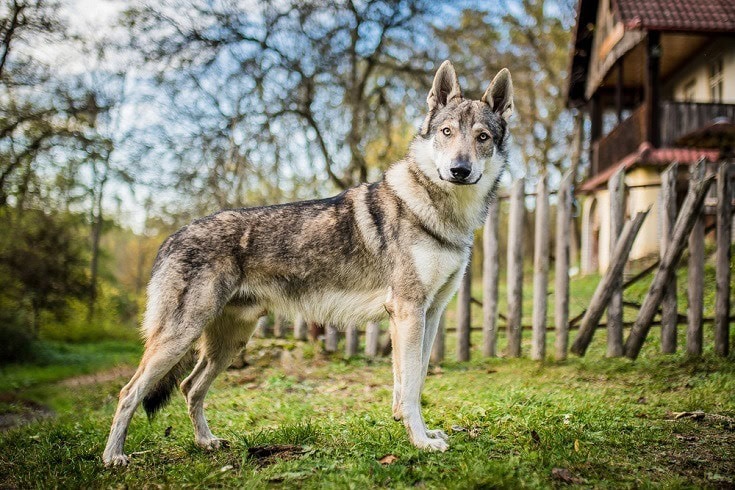
| Category: | Foundation Stock Service |
| Height: | 23–30 inches |
| Weight: | 70–100 pounds |
| Colors: | Gray, white |
It’s no surprise that this domestic breed inches closer and in some cases, grows bigger than actual wild wolves. That is because they are a direct combination of a domestic dog mixed with a Gray, Eastern, or Red Wolf.
These hybrids require special handlers, so always make sure to do your research before inviting a wolf-sized pup into your home.
Origin
Wolfdogs are still bred with wild wolves and domestic dogs today. However, certain breeds, like the Czechoslovakian Wolfdog, have earned a reputation. Until breeding is perfected, it is likely to continue by wolf dogs breeding with wolves.
Today, they are only legal in certain areas. Always check local laws and obtain proper permits, if necessary.
Personality
Because the Wolfdog is so unique, they require experienced owners. These dogs will require lots of one-on-one time and specific training to help them be a well-rounded member of the family. These hybrids are definitely not ideal picks for first-timers or large families.
Since they have such wild roots, these dogs might not be able to befriend strangers or other pets. It’s important to understand the unique complications that could come along with owning one of these animals.
Health
Wolfdogs are generally healthy, but they can take on issues from either parent in the equation.
Some potential issues include:
- Hip and elbow dysplasia
- Dental problems
- Eye conditions
- Degenerative myelopathy
3. Mastiff
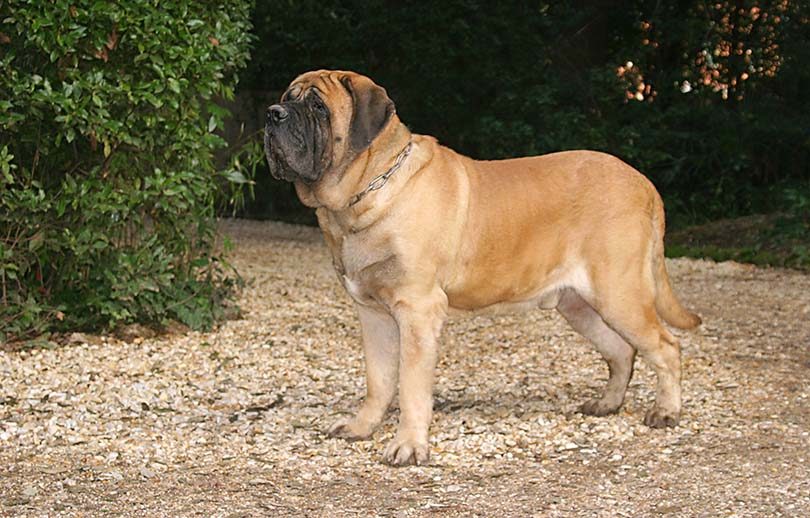
| Category: | Working Group |
| Height: | 25–27 inches |
| Weight: | 100–200 pounds |
| Colors: | Bicolor, brindle |
Mastiffs have long since been revered for their gentle approach and regal behavior. The Mastiff makes an award-winning nanny, family protector, and household guardian—what more could you want?
These beautiful dogs can outweigh their wild cousins by 50 pounds or more. So, while a wolf might beat them in areas like agility, these dogs take the cake in size.
Origin
Historically, Mastiffs were working dogs who stood guard. They also have roots in fighting, displaying traits of bravery and dignity.
It might be hard to tell when you meet these gentle giants, but they have quite a violent history. These dogs were used to defeat large predators like bears, bulls, lions, and tigers. So, wolves might be less of a match.
Personality
Mastiffs make amazing family companions and work well in just about any lifestyle. While we might not recommend them for very small living spaces, their personalities make them compatible with so many folks.
Mastiffs are motherly, protective, and patient. They have all the key traits that make them impeccable with children, but it also makes them extremely skilled at watching things at home.
Health
Here are some health issues Mastiffs might face:
- Hip and elbow dysplasia
- Epilepsy
- Cancer
- Entropion
- Bloat
- Bone tumor
- Urinary tract infections
4. Newfoundland
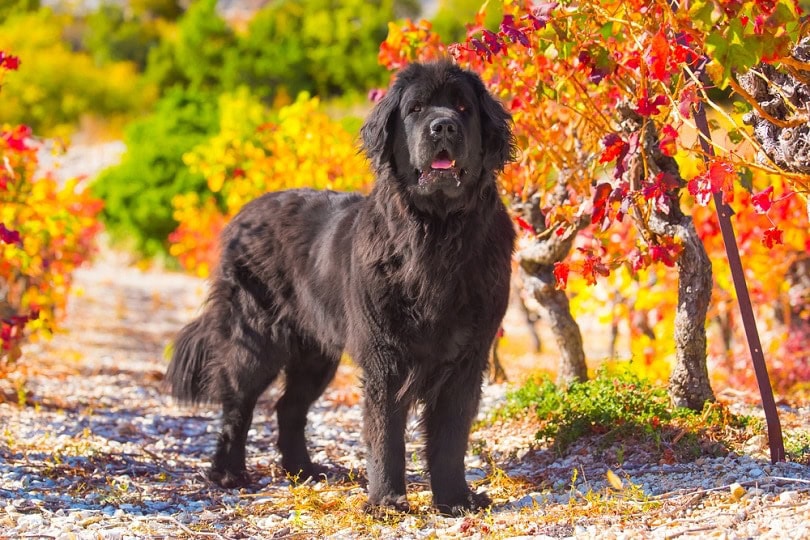
| Category: | Working Group |
| Height: | 25–28 inches |
| Weight: | 100–150 pounds |
| Colors: | Black, black and white, brown, gray |
Newfoundlands have won the popular vote among dog lovers everywhere. These larger-than-life teddy bear dogs are both adorable and lovable, making a perfect pooch.
Newfoundlands can get up to 150 pounds, larger than many wolves. While their calm demeanor and physical appearance are much different, they remain one of the most giant domestic breeds.
Origin
Newfoundlands are closely related to water dogs like Irish Water Spaniels and Labradors. They have tremendous swimming capabilities and were used as working dogs for wetlands. Because of the webbed feet and sharp senses of the Newfoundland, they fit the role to a T.
However, humans were taken over by the breed’s humble and docile personality. So, it is not a surprise that most Newfoundlands today are house pets that only play in the water for fun—not sport.
Personality
Newfoundlands are well-revered for their friendliness. They have an incredibly calm demeanor, known as a gentle giant breed that is an easy pick for even first-timers. These cuddle bugs make excellent playmates and cuddle buddies.
The Newfie is a massive dog whose heart is just as big. Most would agree that this breed doesn’t have a mean bone in its body. Therefore, these intelligent, gentle pups are perfect for homes with children and adults of all ages.
Health
- Hip and elbow dysplasia
- Epilepsy
- Heart disease
- Cystinuria
- Bloat
- Osteosarcoma
- Aortic stenosis
- Obesity
- Allergies
5. Great Pyrenees
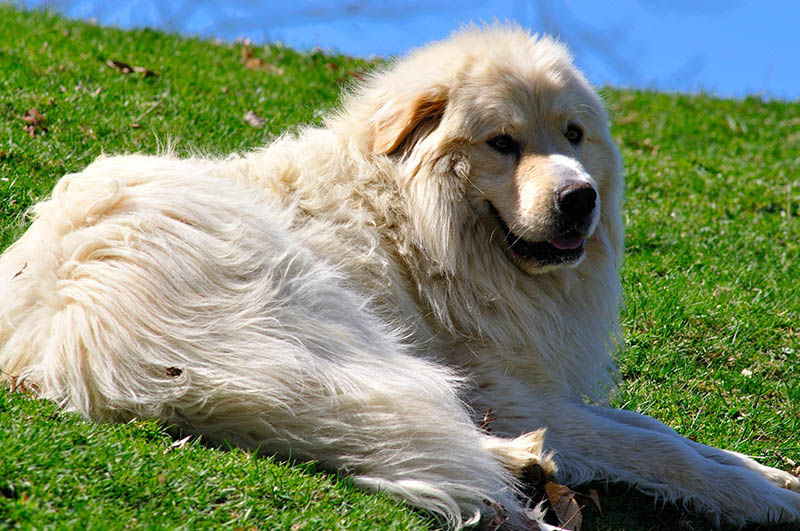
| Category: | Working Group |
| Height: | 28–32 inches |
| Weight: | 80–100 pounds |
| Colors: | White |
The Great Pyrenees may have been hard workers in the old days, but they have transitioned beautifully to domestic life. Many folks still keep these pups around for guarding livestock, as they are excellent at diverting predators on small and large farms.
While a Great Pyrenees doesn’t do so great in small living spaces, they make terrific additions to homes with acreage and open space.
Origin
The Great Pyrenees hails from Asia—particularly Central Asia and Siberia. This breed has been around since nearly 1800 BC. They were guard dogs that looked after farm animals, protecting the flocks and herds when the farmer was not in sight.
They quickly became popular due to their docile demeanor and agreeable nature. Today, you can find them in shows, emotional support roles, and so on.
Personality
The Great Pyrenees has an incredibly docile temperament. They are watchful but slow to act. They will protect their pack if they feel like their family is being threatened. However, these light-hearted dogs give everyone a chance until someone breaks their trust.
You can always count on a Great Pyrenees to be a wonderful protector, and they should be a top contender if you’re considering an emotional support animal.
Health
The Great Pyrenees was built to withstand the elements. So, they run into a few health issues, but we’d still like to mention them.
These ailments include:
- Hip and elbow dysplasia
- Eye disorders
- Luxating patella
- Neurological disorders
- Immune disorders
6. Cane Corso
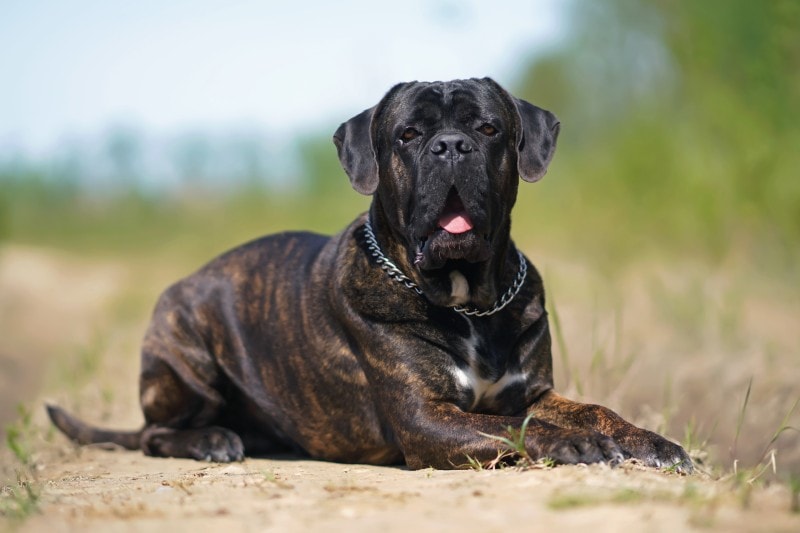
| Category: | Miscellaneous Group |
| Height: | 25–28 inches |
| Weight: | 80–110 pounds |
| Colors: | Black, fawn, brindle, gray, red |
The impressive Cane Corso has an undeniable presence. They have an incredibly tough stance, giving way to their reputation of strength and power. In addition to being sturdy specimens, they also have personalities to win any dog lover over.
Even though these dogs look very different from wolves, they share the same drastic size. Many of them are not quite as big as wolves on the higher end of the spectrum, but they certainly can outweigh a majority of females.
Origin
The Cane Corso originated in southern Italy. Alongside the Neapolitan Mastiff, the Cane Corso was developed from descendants of ancient Roman war dogs. These dogs were considered a very rare breed up until roughly 1988.
The name Cane Corso in Latin translates to “guardian.” These dogs are nothing short of protectors, still taking on that role today. They take this duty very seriously and require experienced owners to match their unique care requirements.
Personality
The Cane Corso creates very strong bonds with their family. These dogs can acclimate well into households with children and pets if it is done early and properly. However, these assertive and willful dogs can also be a challenge for less experienced owners.
Cane Corsos are brilliant dogs that can be slightly aloof with strangers. With proper socialization, they can be agreeable, but with the wrong experience, it can create trust issues. Always train your Cane Corso with a firm hand but use positive reinforcement only for the best results.
Health
For the most part, Cane Corsos are healthy dogs with few issues. However, specific problems might show up in the breed.
Some of these include:
- Hip and elbow dysplasia
- Idiopathic epilepsy
- Demodex mange
- Eyelid abnormalities
7. Saint Bernard
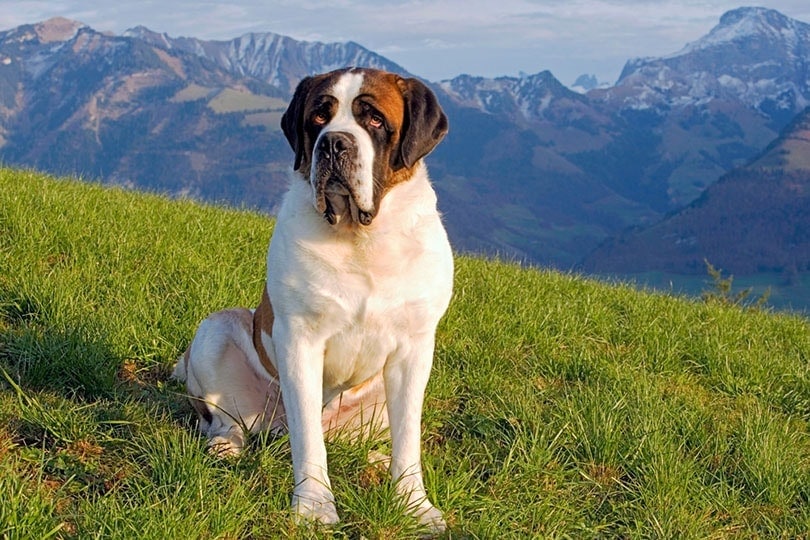
| Category: | Working Group |
| Height: | 28–30 inches |
| Weight: | 120–140 pounds |
| Colors: | Brownish yellow, red and white, brindle, splash, mantle |
The Saint Bernard is an all-American dog, winning our hearts through films like Beethoven. This large working breed has really made its mark on the world, gaining in popularity over the years.
In addition to making wonderful family companions, Saint Bernards are more often seen in emotional support or service dog roles, as they really have the personality for it.
Origin
The Saint Bernard is yet another working breed that was developed in the western Alps. This breed, hailing from Switzerland, worked in very rugged terrain, which is why they have such long, thick fur.
They were originally granted roles in rescue service. Since then, they have adapted to guard livestock and families all around the globe.
Personality
Saint Bernards are well revered for having a place alongside families of any size. Because the Saint Bernard is huge, they might knock over very small children. But with proper rearing, the two can get along well and make excellent playmates.
Many Saint Bernards tend to be loving and protective, making them incredibly doting toward owners and even friendly toward strangers. They have an overabundance of hair and quite a lot of slobber, but their loving nature makes up for all those extra sloppy kisses.
Health
Many ailments plaguing the Saint Bernard can be avoided with proper breeding practices.
However, certain issues still crop up in the breed, such as:
- Hip and elbow dysplasia
- Addison’s disease
- Cancer
- Eye problems
- Osteochondrosis
- Thyroiditis
8. Tibetan Mastiff
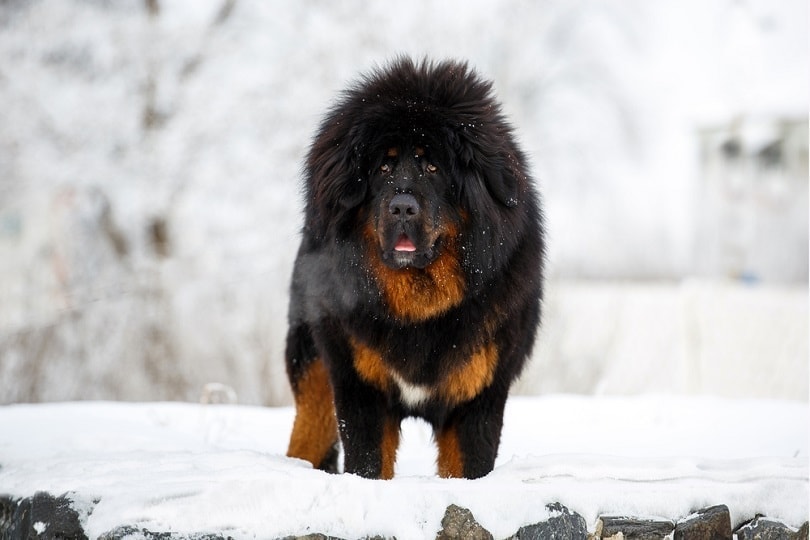
| Category: | Working Group |
| Height: | 24–26 inches |
| Weight: | 70–200 pounds |
| Colors: | Black, black and tan, brown and tan, brown, red gold, blue gray |
The Tibetan Mastiff is an enormous beast. The largest recorded Tibetan Mastiff weighed 250 pounds! So, these things can definitely out-size a wild wolf any day—and they would try if threatened.
These interesting dogs resemble lions—and they share their fearlessness and boldness.
Origin
The Tibetan Mastiff has significant ancestral roots. Initially, these dogs were raised by Tibetan nomads and guarded great monasteries in the country. These guardian dogs have mythical roots, providing lots of stories for generations past.
Today, this is a rare Mastiff breed to see. These incredible creatures are typically only paired with very experienced canine owners who have a tremendous understanding of the breed itself.
Personality
The Tibetan Mastiff isn’t one for playing games–they mean business. These dogs have excellent discernment and stand on guard, waiting to protect one of their pack members. They have a very watchful, aloof personality towards strangers and can appear very intimidating.
Because these dogs have a wildlife nature to them, they should only be with owners who can handle the complexities. Since this dog is physically hard to handle, it will take a patient owner who’s willing to provide the proper obedience training.
Health
The Tibetan Mastiff is a rare and expensive breed. However, most of their health concerns come from poor breeding practices.
Here are some health concerns to mention:
- Hip and elbow dysplasia
- Autoimmune thyroiditis
- Seizures
- Canine inherited demyelinating neuropathy
Wolf General Makeup

Wolves are agile, muscular animals with incredible physical capabilities. On average, wolves weigh anywhere from 70 to 130 pounds. Some males can get upwards of 180 pounds, depending on genetics.
Wolves are impressive hunters and fighters. It might surprise you just how much damage one wolf can do. Domesticated dogs generally don’t have the instinctual need to be as aggressive or physically fit.
It’s amazing to see how the descendants of these wolves can now outweigh their ancestors.
Final Thoughts
It is incredible to look at these domestic dogs and how different they are from their wild wolf cousins. Dogs have changed so much in appearance over the years, creating some of the most interesting-looking breeds.
Even though these dogs are very different from one another, they have one thing in common—each one can get absolutely massive. If you’re interested in a giant breed, do research about general care beforehand, as these matters can be unique.
Featured Image Credit: rzoze19, Shutterstock



